

Compact Muon Solenoid
LHC, CERN
| CMS-SMP-15-008 ; CERN-EP-2017-039 | ||
| Measurements of the $ \mathrm{ pp \to W \gamma\gamma } $ and $ \mathrm{ pp \to Z \gamma\gamma } $ cross sections and limits on anomalous quartic gauge couplings at $ \sqrt{s} = $ 8 TeV | ||
| CMS Collaboration | ||
| 3 April 2017 | ||
| J. High Energy Phys. 10 (2017) 072 | ||
| Abstract: Measurements are presented of $ \mathrm{ W \gamma\gamma } $ and $ \mathrm{ Z \gamma\gamma } $ production in proton-proton collisions. Fiducial cross sections are reported based on a data sample corresponding to an integrated luminosity of 19.4 fb$^{-1}$ collected with the CMS detector at a center-of-mass energy of 8 TeV. Signal is identified through the $\mathrm{ W } \to \ell\nu$ and $\mathrm{ Z }\to\ell\ell$ decay modes, where $\ell$ is a muon or an electron. The production of $ \mathrm{ W \gamma\gamma } $ and $ \mathrm{ Z \gamma\gamma } $, measured with significances of 2.6 and 5.9 standard deviations, respectively, is consistent with standard model predictions. In addition, limits on anomalous quartic gauge couplings in $ \mathrm{ W \gamma\gamma } $ production are determined in the context of a dimension-8 effective field theory. | ||
| Links: e-print arXiv:1704.00366 [hep-ex] (PDF) ; CDS record ; inSPIRE record ; HepData record ; CADI line (restricted) ; | ||
| Figures | |
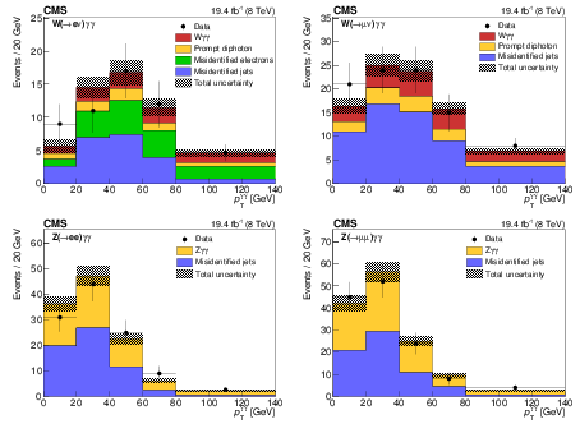
png pdf |
Figure 1:
Distributions of the diphoton $ {p_{\mathrm {T}}} $ for the $ { {\mathrm {W}} \gamma \gamma } $ (upper) and $ { {\mathrm {Z}} \gamma \gamma } $ (lower) analyses, in the electron(left) and muon(right) channels. The points display the observed data and the histograms show the predictions for the background and signal. The hatched area displays the total uncertainty in the sum of these predictions. The predictions for electrons and jets misidentified as photons are obtained with data-based methods. The remaining background and signal predictions are derived from MC simulation. The last bin includes all events in which the diphoton $ {p_{\mathrm {T}}} $ exceeds 80 GeV. |

png pdf |
Figure 1-a:
Distribution of the diphoton $ {p_{\mathrm {T}}} $ for the $ { {\mathrm {W}} \gamma \gamma } $ analysis, in the electron channel. The points display the observed data and the histograms show the predictions for the background and signal. The hatched area displays the total uncertainty in the sum of these predictions. The predictions for electrons and jets misidentified as photons are obtained with data-based methods. The remaining background and signal predictions are derived from MC simulation. The last bin includes all events in which the diphoton $ {p_{\mathrm {T}}} $ exceeds 80 GeV. |

png pdf |
Figure 1-b:
Distribution of the diphoton $ {p_{\mathrm {T}}} $ for the $ { {\mathrm {W}} \gamma \gamma } $ analysis, in the muon channel. The points display the observed data and the histograms show the predictions for the background and signal. The hatched area displays the total uncertainty in the sum of these predictions. The predictions for electrons and jets misidentified as photons are obtained with data-based methods. The remaining background and signal predictions are derived from MC simulation. The last bin includes all events in which the diphoton $ {p_{\mathrm {T}}} $ exceeds 80 GeV. |
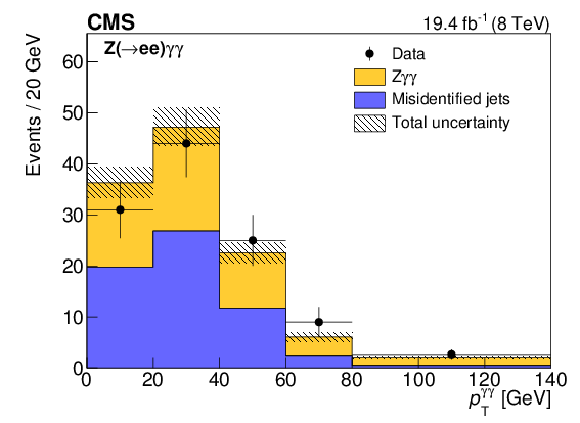
png pdf |
Figure 1-c:
Distribution of the diphoton $ {p_{\mathrm {T}}} $ for the $ { {\mathrm {Z}} \gamma \gamma } $ analysis, in the electron channel. The points display the observed data and the histograms show the predictions for the background and signal. The hatched area displays the total uncertainty in the sum of these predictions. The predictions for electrons and jets misidentified as photons are obtained with data-based methods. The remaining background and signal predictions are derived from MC simulation. The last bin includes all events in which the diphoton $ {p_{\mathrm {T}}} $ exceeds 80 GeV. |
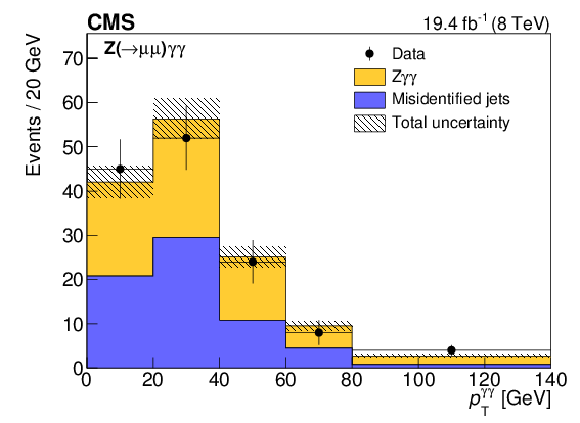
png pdf |
Figure 1-d:
Distribution of the diphoton $ {p_{\mathrm {T}}} $ for the $ { {\mathrm {Z}} \gamma \gamma } $ analysis, in the muon channel. The points display the observed data and the histograms show the predictions for the background and signal. The hatched area displays the total uncertainty in the sum of these predictions. The predictions for electrons and jets misidentified as photons are obtained with data-based methods. The remaining background and signal predictions are derived from MC simulation. The last bin includes all events in which the diphoton $ {p_{\mathrm {T}}} $ exceeds 80 GeV. |

png pdf |
Figure 2:
Distributions of the diphoton $ {p_{\mathrm {T}}} $ for the $ { {\mathrm {W}} \gamma \gamma } $ (left) and $ { {\mathrm {Z}} \gamma \gamma } $ (right) analyses with the electron and muon channels summed. The points display the observed data and the histograms give the predictions for the background and signal. The hatched area displays the total uncertainty in the sum of these predictions. The predictions for electrons and jets misidentified as photons are obtained with data-based methods. The remaining background and signal predictions are derived from MC simulation. The last bin includes all events in which the diphoton $ {p_{\mathrm {T}}} $ exceeds 80 GeV. |
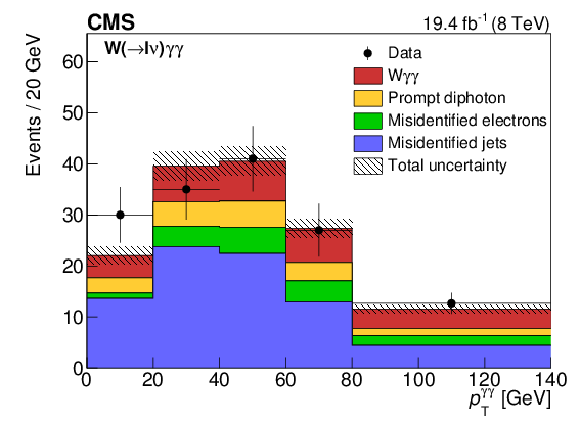
png pdf |
Figure 2-a:
Distributions of the diphoton $ {p_{\mathrm {T}}} $ for the $ { {\mathrm {W}} \gamma \gamma } $ analysis with the electron and muon channels summed. The points display the observed data and the histograms give the predictions for the background and signal. The hatched area displays the total uncertainty in the sum of these predictions. The predictions for electrons and jets misidentified as photons are obtained with data-based methods. The remaining background and signal predictions are derived from MC simulation. The last bin includes all events in which the diphoton $ {p_{\mathrm {T}}} $ exceeds 80 GeV. |

png pdf |
Figure 2-b:
Distributions of the diphoton $ {p_{\mathrm {T}}} $ for the $ { {\mathrm {Z}} \gamma \gamma } $ analysis with the electron and muon channels summed. The points display the observed data and the histograms give the predictions for the background and signal. The hatched area displays the total uncertainty in the sum of these predictions. The predictions for electrons and jets misidentified as photons are obtained with data-based methods. The remaining background and signal predictions are derived from MC simulation. The last bin includes all events in which the diphoton $ {p_{\mathrm {T}}} $ exceeds 80 GeV. |

png pdf |
Figure 3:
Distributions of the leading photon $ {p_{\mathrm {T}}} $ for the $ { {\mathrm {W}} \gamma \gamma } $ analysis with the electron and muon channels summed. The points display the observed data and the histograms give the predictions for the background and signal. The hatched area displays the total uncertainty in the sum of these predictions. The expected distribution with the inclusion of an aQGC with $ {f_{\mathrm {T},0}}/\Lambda ^{4} = $ 50 TeV$ ^{-4}$ is shown as the dashed line. The last bin includes all events in which the leading photon ${p_{\mathrm {T}}}$ exceeds 70 GeV. |
| Tables | |
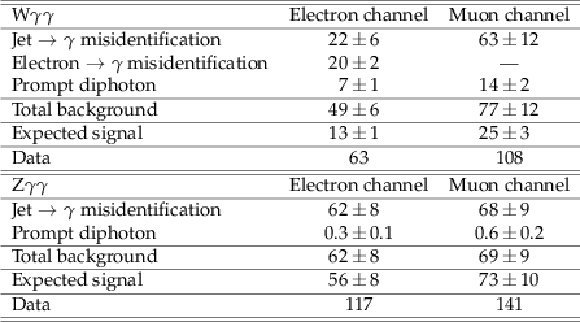
png pdf |
Table 1:
Background composition, expected signal, and observed yields in the $ { {\mathrm {W}} \gamma \gamma } $ (upper) and $ { {\mathrm {Z}} \gamma \gamma } $ (lower) analyses. |

png pdf |
Table 2:
Fiducial region definitions for the $ { {\mathrm {W}} \gamma \gamma } $ analysis (upper) and $ { {\mathrm {Z}} \gamma \gamma } $ analysis (lower). The transverse mass $ {m_\mathrm {T}} $ is defined as in the event selection, but with ${ {p_{\mathrm {T}}} ^\text {miss}}$ replaced by the neutrino transverse momentum. In particular, $ {m_\mathrm {T}} = \sqrt { { 2p^{\ell }_\mathrm {T}p^{\nu }_\mathrm {T} (1 - \cos [\phi (\vec{p}^{\ell }_\mathrm {T})- \phi (\vec{p}^{\nu }_\mathrm {T})])}}$. |

png pdf |
Table 3:
Systematic and statistical uncertainties affecting the $ { {\mathrm {W}} \gamma \gamma } $ and $ { {\mathrm {Z}} \gamma \gamma } $ fiducial cross section measurements, presented as percentages of the measured cross section. |
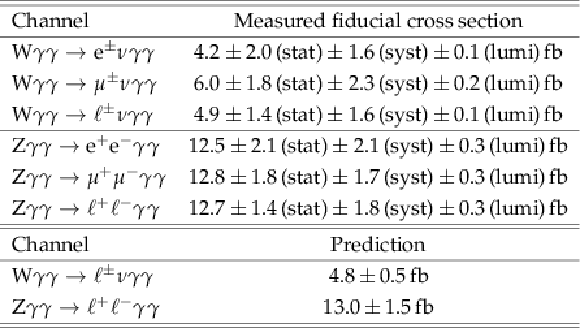
png pdf |
Table 4:
Measured fiducial cross section for each channel and for the combination of channels for the $ { {\mathrm {W}} \gamma \gamma } $ and $ { {\mathrm {Z}} \gamma \gamma } $ analyses. The combined cross sections assume lepton universality and are given for the decay to a single lepton family ($\ell $). The predictions are reported as well. |
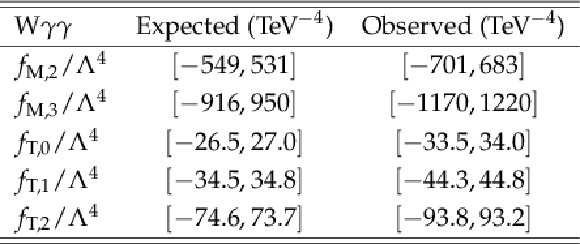
png pdf |
Table 5:
Expected and observed 95% CL limits on anomalous quartic gauge couplings. Limits are obtained using $ { {\mathrm {W}} \gamma \gamma } $ events in which the leading photon $ {p_{\mathrm {T}}} $ exceeds 70 GeV. |
| Summary |
| Cross sections have been measured for $ \mathrm{ W \gamma\gamma } $ and $ \mathrm{ Z \gamma\gamma } $ production in pp collisions at $ \sqrt{s} = $ 8 TeV using data corresponding to an integrated luminosity of 19.4 fb$^{-1}$ collected with the CMS experiment. The cross sections were measured in fiducial regions that are defined by criteria similar to those used to select signal events. The fiducial cross sections are defined for W and Z boson decays to a single lepton family. The measured fiducial cross sections for these final states are, respectively, 4.9 $\pm$ 2.1 fb and 12.7 $\pm$ 2.3 fb, consistent with the NLO theoretical predictions of 4.8 $\pm$ 0.5 fb and 13.0 $\pm$ 1.5 fb. These measurements correspond to significances for observing the signal of 2.6 and 5.9 standard deviations for the $ \mathrm{ W \gamma\gamma } $ and $ \mathrm{ Z \gamma\gamma } $ final states, respectively. The $ \mathrm{ W \gamma\gamma } $ final state is used to place limits at 95% CL on anomalous quartic gauge couplings using a dimension-8 effective field theory. In particular, stringent limits are placed on the $f_{\mathrm{T},0}/\Lambda^4$ coupling parameter of $-33.5 < f_{\mathrm{T},0}/\Lambda^4/\Lambda^4 < 34.0$ TeV$^{-4}$. |
| References | ||||
| 1 | ATLAS Collaboration | Evidence of $ W\gamma\gamma $ production in $ pp $ collisions at $ \sqrt{s}= $ 8 TeV and limits on anomalous quartic gauge couplings with the ATLAS detector | PRL 115 (2015) 031802 | 1503.03243 |
| 2 | ATLAS Collaboration | Measurements of $ Z\gamma $ and $ Z\gamma\gamma $ production in $ pp $ collisions at $ \sqrt{s}= $ 8 TeV with the ATLAS detector | PRD 93 (2016) 112002 | 1604.05232 |
| 3 | G. Bozzi, F. Campanario, M. Rauch, and D. Zeppenfeld | $ W\gamma \gamma $ production with leptonic decays at NLO QCD | PRD 83 (2011) 114035 | 1103.4613 |
| 4 | G. Bozzi, F. Campanario, M. Rauch, and D. Zeppenfeld | $ \mathrm{Z}\gamma\gamma $ production with leptonic decays and triple photon production at next-to-leading order QCD | PRD 84 (2011) 074028 | 1107.3149 |
| 5 | CMS Collaboration | The CMS experiment at the CERN LHC | JINST 3 (2008) S08004 | CMS-00-001 |
| 6 | CMS Collaboration | Particle-flow reconstruction and global event description with the CMS detector | CMS-PRF-14-001 1706.04965 |
|
| 7 | CMS Collaboration | Performance of CMS muon reconstruction in pp collision events at $ \sqrt{s}= $ 7 TeV | JINST 7 (2012) P10002 | CMS-MUO-10-004 1206.4071 |
| 8 | W. Adam, R. Fruhwirth, A. Strandlie, and T. Todorov | Reconstruction of electrons with the Gaussian-sum filter in the CMS tracker at the LHC | JPG 31 (2005) N9 | |
| 9 | CMS Collaboration | Performance of electron reconstruction and selection with the CMS detector in proton-proton collisions at $ \sqrt{s} = $ 8 TeV | JINST 10 (2015) P06005 | CMS-EGM-13-001 1502.02701 |
| 10 | CMS Collaboration | Performance of photon reconstruction and identification with the CMS detector in proton-proton collisions at $ \sqrt{s} = $ 8 TeV | JINST 10 (2015) P08010 | CMS-EGM-14-001 1502.02702 |
| 11 | CMS Collaboration | Jet energy scale and resolution in the CMS experiment in pp collisions at 8 TeV | JINST 12 (2017) P02014 | CMS-JME-13-004 1607.03663 |
| 12 | CMS Collaboration | The CMS trigger system | JINST 12 (2017) P01020 | CMS-TRG-12-001 1609.02366 |
| 13 | J. Alwall et al. | The automated computation of tree-level and next-to-leading order differential cross sections, and their matching to parton shower simulations | JHEP 07 (2014) 079 | 1405.0301 |
| 14 | NNPDF Collaboration | Parton distributions for the LHC run II | JHEP 04 (2015) 040 | 1410.8849 |
| 15 | T. Sjostrand, S. Mrenna, and P. Z. Skands | A brief introduction to PYTHIA 8.1 | CPC 178 (2008) 852 | 0710.3820 |
| 16 | P. Skands, S. Carrazza, and J. Rojo | Tuning PYTHIA 8.1: the Monash 2013 Tune | EPJC 74 (2014) 3024 | 1404.5630 |
| 17 | J. Pumplin et al. | New generation of parton distributions with uncertainties from global QCD analysis | JHEP 07 (2002) 012 | hep-ph/0201195 |
| 18 | T. Sjostrand, S. Mrenna, and P. Skands | PYTHIA 6.4 physics and manual | JHEP 05 (2006) 026 | hep-ph/0603175 |
| 19 | CMS Collaboration | Study of the underlying event at forward rapidity in pp collisions at $ \sqrt{s} = $ 0.9 , 2.76, and 7 TeV | JHEP 04 (2013) 072 | CMS-FWD-11-003 1302.2394 |
| 20 | C. Degrande et al. | UFO --- the Universal FeynRules Output | CPC 183 (2012) 1201 | 1108.2040 |
| 21 | J. M. Campbell and R. K. Ellis | MCFM for the Tevatron and the LHC | NPPS 205-206 (2010) 10 | 1007.3492 |
| 22 | N. Davidson et al. | Universal interface of TAUOLA: Technical and physics documentation | CPC 183 (2012) 821 | 1002.0543 |
| 23 | GEANT4 Collaboration | GEANT4---a simulation toolkit | NIMA 506 (2003) 250 | |
| 24 | CMS Collaboration | Description and performance of track and primary-vertex reconstruction with the CMS tracker | JINST 9 (2014) P10009 | CMS-TRK-11-001 1405.6569 |
| 25 | M. Grazzini, S. Kallweit, and D. Rathlev | W$ \gamma $ and Z$ \gamma $ production at the LHC in NNLO QCD | JHEP 07 (2015) 085 | 1504.01330 |
| 26 | S. Frixione | Isolated photons in perturbative QCD | PLB 429 (1998) 369 | hep-ph/9801442 |
| 27 | A. D. Martin, W. J. Stirling, R. S. Thorne, and G. Watt | Parton distributions for the LHC | EPJC 63 (2009) 189 | 0901.0002 |
| 28 | H.-L. Lai et al. | New parton distributions for collider physics | PRD 82 (2010) 074024 | 1007.2241 |
| 29 | CMS Collaboration | CMS luminosity based on pixel cluster counting --- Summer 2013 update | CMS-PAS-LUM-13-001 | CMS-PAS-LUM-13-001 |
| 30 | L. Lyons, D. Gibaut, and P. Clifford | How to combine correlated estimates of a single physical quantity | NIMA 270 (1988) 110 | |
| 31 | A. Valassi | Combining correlated measurements of several different physical quantities | NIMA 500 (2003) 391 | |
| 32 | R. Nisius | On the combination of correlated estimates of a physics observable | EPJC 74 (2014) 3004 | |
| 33 | C. Degrande et al. | Effective field theory: A modern approach to anomalous couplings | Annals Phys. 335 (2013) 21 | 1205.4231 |
| 34 | G. Belanger et al. | Bosonic quartic couplings at LEP2 | EPJC 13 (2000) 293 | hep-ph/9908254 |
| 35 | O. J. P. Eboli, M. C. Gonzalez-Garcia, and J. K. Mizukoshi | $ pp\to jje^\pm\mu^\pm\nu\nu $ and $ jje^\pm\mu^\mp\nu\nu $ at $ o(\alpha_{em}^6) $ and $ o(\alpha_{em}^4\alpha_s^2) $ for the study of the quartic electroweak gauge boson vertex at CERN LHC | PRD 74 (2006) 073005 | hep-ph/0606118 |
| 36 | M. Baak et al. | Study of electroweak interactions at the energy frontier | 1310.6708 | |

|
Compact Muon Solenoid LHC, CERN |

|

|

|

|

|

|